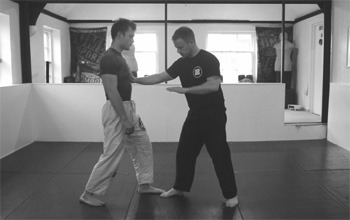Re-learning how to move, the first step of the practice
 |
| Animals don't have any issues with their movement patterns |
If I have been using my body for 37 years now and have been practicing martial arts for over twenty years, it was only about ten years ago that I started opening my eyes to the use of the human body and to really change my perspective on martial practice, but also more broadly on what it means to inhabit one's body.
When looking at the most incredible adepts, it is striking that they all seem to have something more, which usually translates into a feeling of ease in what they do. This is the case in martial practices, but also in many sports as demonstrated by top-level athletes such as Roger Federer, Cristiano Ronaldo or Kelly Slater. Beyond their technique, obviously impeccable at this level, these athletes always show a perfectly organised body, and it is extremely rare to see them failing from this point of view.
Yet, they seem to be more an exception than the rule and we just need tp look around us, in the street or on the mats to realize that the majority of people have a difficult relationship with their body.
Where do these issues come from?
The origin of these problems is interesting. Animals don't have any problem with their movement patterns, and neither do young children. Obviously the latter have difficulties, since they have to acquire these patterns, learn how to sit, crawl, stand up, walk. However, despite having a particularly heavy head compared to the rest of the body, they very quickly find stability and learn to manage this weight effectively. It is only later that difficulties arise.
However, it is very likely that our hunter-gatherer ancestors, who moved constantly and in a variety of ways did not have this kind of problem either, living fully in harmony with their body.
One of the major reasons for this disruption of our body patterns is related to our modern societies and to one of their consequences: sedentary lifestyle. The comfort of modernity is obviously not a bad thing in itself, and we can only appreciate that not to live in caves or be at the mercy of the elements and predators any longer. But it also has consequences.
The main one is certainly a sedentary lifestyle. Human beings are wired to rest when they have an opportunity because in a hostile environment this resting time can allow them to recover enough energy to escape danger later. That's a good thing… as long as the resting opportunities don't outweigh the opportunities for movement. Even going to the gym or the dojo 2 hours every day (which is probably already well above average), how could those 2 hours make up for 10 hours spent in a sitting position (transport, office, meals)? The reality is that modern men have become experts in the art of being still. Just imagine your level of practice if you could spend those 10 hours a day training.
Why is this a problem?
The human body is made for movement, and more precisely for a wide variety of movements (walking, running, jumping, swimming, climbing, catching, throwing, etc.). But as the expression “Use it or lose it!” says, sedentary lifestyle rewires our body and contributes to tissue atrophy. Spending 10 hours a day sitting or 16 hours a day in rigid shoes deeply impacts our ability to use our muscles, tendons and joints correctly and forces our body to adapt around these new constraints and to use other tissues to achieve the work of those that have become unusable.
At this point, I wouldn't blame you for believing that I am strongly exaggerating and therefore I will ask you a question: what happens when you put a cast on a part of your body (arm, ankle, knee, wrist, finger) for several weeks and you then remove the cast? When I removed my finger splint after a fracture, it was obviously difficult for me to move the joint that had been broken. But moving the previous joint, which had also been immobilized but had not been damaged by the accident was just as difficult and it was only after a few weeks that I was able to recover in functionality.
Now imagine the damage done by decades in any unique position.
It is therefore from problematic body movement patterns that we begin to practice. And this practice most often involves adding load, repetition, or speed to a shoddy movement. A recipe for disaster. Suburi are an excellent example of this and lockdowns across the world unfortunately gave an opportunity to many practitioners to go and destroy their bodies a little more, by responding to challenges such as achieving 1000 suburi per day… Watching some videos, I regretted not be an osteopath.
Let's be clear, I don't have a problem with suburi but I believe it is essential to first improve one’s quality of movement before performing sets of 1000 repetitions of anything.
“We tend to look at sport as a kind of dietary supplement to solve our sedentary lifestyle problems. If you are missing a particular nutrient, you can take it as a dietary supplement to compensate for this deficiency. It doesn't work the same way for physical exercise.
Being sedentary all day reduces the quality of your movement, so when you exercise, you are just putting repetitions or load on poor quality movement, and that often leads to injury. Typically, the most common profile I saw in the clinic was a sedentary person who ran or did high-intensity workouts every day, but remained seated most of the day. And that's what was causing the injuries. The solution is not to add more physical exercise, but to reduce the sedentary lifestyle which has a negative effect on our quality of movement. Only then will you be able to exercise more. ”
Nick St Louis, Founder of the Foot Collective, for Yashima
What is the solution?
Start by moving.
I believe the first step is to allow the body to perform a variety of movements, constantly, and not to limit oneself to physical exercise a few hours a day. If you think of physical exercise as the 15 exercises that you can do in the gym, these are only a tiny fraction of what the human body is capable of doing. Everything, on the other hand, is movement. Getting out of bed, brushing your teeth, walking, sitting, squatting down to pick up something.
And all movement (or lack of) impacts every cell in our body through the process of mechanotransduction. In other words, we are what we do. On this subject, I can only recommend Katy Bowman’s excellent book, Move your DNA, which wonderfully explains this process and the consequences of a sedentary lifestyle on our entire body.
If human beings are wired to rest whenever they get the chance, it also means looking at how to remove temptations to rest and replace them with opportunities to move. A comfortable sofa, for example, is a call to crime, but moving it away from the TV can make it less appealing. Covering the floor with a mat can also be a good encouragement to sit on the floor, which will have a positive impact on hip mobility. Personally, my living room being covered with mats, I have not sat on my sofa for more than 2 minutes in a row for months. Likewise, I have designed my apartment in such a way that I only have to extend my arms out to get an opportunity for movement, with weapons accessible everywhere, massage balls for the feet, WAFFs (proprioception air cushions) in the living room, and a beam in my working room (where by the way I have no chair or desk).
It is then necessary to take a closer look at how the body is supposed to move to fix alignments and restore functionaility. Cleaning tensions in the body should be the number 1 priority of the martial arts practitioner, before even taking an interest in any technical work. I remain amazed that PE lessons in school are generally designed to provide basic sports education (i.e. present sports activities and their rules) leaving aside physical education itself which could already allow as many people as possible to better understand the functioning of the human body and its optimal use ...
In a recent podcast with Tim Ferris, Peter Attia also covered this subject by evoking his bodybuilding training, during which his coach formally prohibited him from putting weights on the bar until his movement would be clean enough. Despite the frustration of raising an empty bar, I am convinced of the validity of such a method in the medium to long term.
My practice today
My current practice focuses on the body, its development and functionality. If I have always been athletic, it was only a few years ago that I realized that my body was not really functional, and after chatting with Nick St Louis I realized that despite intense practice, I was a sedentary person.
“One thing we look at, for example, is what it means to be active, or conversely to be sedentary. Because if you sit eight hours a day but exercise three hours a day, that makes you a sedentary person who exercises, not an active person. ”
Nick St Louis, Founder of the Foot Collective, for Yashima
It is therefore a question of understanding the functioning of the body, eliminating tensions and rediscovering a functionality as broad as possible. In my opinion, it is only possible to actually learn AND make techniques effective when the body is able to apply them. It is obviously possible to have short-term results without going through this step but this will possibly have consequences on a longer term.
During my latest sessions with Akuzawa sensei on Zoom, he repeatedly said that it is essential that we work slowly but with precision. What more can be said?


Commentaires